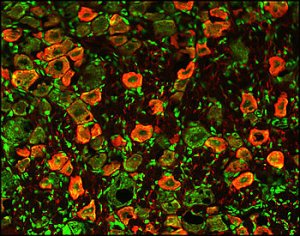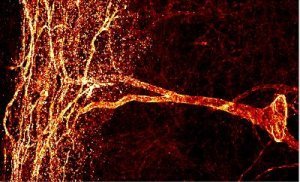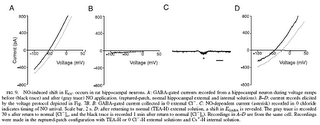 Catalog #: GT15129
Catalog #: GT15129Image: VR1 staining in Rat DRG: red color - TRPV1 labeling, green-counterstain.
Description: VR1, also known as TRPV1 (Transient Receptor Potential Vanilloid 1) and capsaicin receptor, is a 115 kDa integral membrane ion channel that has six transmembrane domains and contains intracellular N-and C-termini. It contributes to normal pain and temperature sensation and also has a "sensory-effector" function. By alternative splicing, at least three VR1 isoforms are known. The sequence of residues 4 - 21 of rat VR1 is 78% and 28% identical to that of mouse and human VR1, respectively.
 Catalog #: RA25001
Catalog #: RA25001Image: NK 1 staining of lamina III neuron in the spinal cord of a rat.
Description: The tachykinins belong to an evolutionary conserved family of peptide neurotransmitters that share the c-terminal sequence Phe-X-Gly-Leu-Met-NH2 and have an established role in neurotransmission. The mammalian tachykinins include substance P, neurokinin A (NKA) and neurokinin B (NKB) which exert their effects by binding to specific receptors. Tachykinin peptides are important in the mediation of many physiological and pathological processes including inflammation, pain, migraine headache and allergy induced asthma. Three tachykinin receptor types have been characterized, NK-1, NK-2 and NK-3 which have preferential affinities for SP, NKA and NKB respectively. All three receptors share a high degree of sequence homology, have seven transmembrane spanning domains and similar signal transduction mechanisms (e.g. G-protein coupled activation of phospholipase C).








